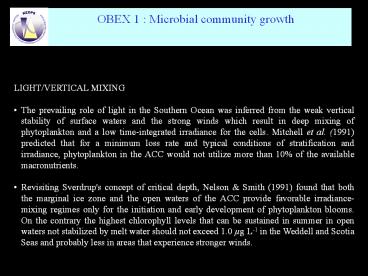Aucun%20titre%20de%20diapositive - PowerPoint PPT Presentation
Title:
Aucun%20titre%20de%20diapositive
Description:
... would be possible only if their diatom assemblages had much lower affinity for ... 30Si, he demonstrated that diatom assemblages could exhibit very low affinity ... – PowerPoint PPT presentation
Number of Views:207
Avg rating:3.0/5.0
Title: Aucun%20titre%20de%20diapositive
1
- LIGHT/VERTICAL MIXING
- The prevailing role of light in the Southern
Ocean was inferred from the weak vertical
stability of surface waters and the strong winds
which result in deep mixing of phytoplankton and
a low time-integrated irradiance for the cells.
Mitchell et al. (1991) predicted that for a
minimum loss rate and typical conditions of
stratification and irradiance, phytoplankton in
the ACC would not utilize more than 10 of the
available macronutrients. - Revisiting Sverdrup's concept of critical depth,
Nelson Smith (1991) found that both the
marginal ice zone and the open waters of the ACC
provide favorable irradiance-mixing regimes only
for the initiation and early development of
phytoplankton blooms. On the contrary the highest
chlorophyll levels that can be sustained in
summer in open waters not stabilized by melt
water should not exceed 1.0 µg L-1 in the Weddell
and Scotia Seas and probably less in areas that
experience stronger winds.
2
- SILICON
- Jacques (1983) called for the possibility of
silicon limitation of Antarctic diatoms. - Nelson Tréguer (1992) summarized available
silicon kinetic and pointed out that Southern
Ocean diatoms seemed to exhibit a very low
affinity (i.e. high KS and Kµ values). However
the first tracer experiments which were done in
the Ross Sea Fragilariopsis curta bloom using
30Si did not support fully the previous results.
Nelson Tréguer (1992) concluded that there was
only weak substrate limitation of Si(OH)4 uptake
rate in the western Ross Sea and that significant
Si limitation in other subsystems of the
Southern Ocean would be possible only if their
diatom assemblages had much lower affinity for
silicic acid than was observed in the Ross Sea. - Caubert (1998) produced the first direct
indication of that possibility during ANTARES 2,
in the POOZ of the Indian sector using 30Si, he
demonstrated that diatom assemblages could
exhibit very low affinity for silicic acid with a
KS value poised to 27 µM.
3
Representative results from 32Si kinetic
experiments (on the left) during AESOPS
(1997-1998) and distribution of KS values (on the
right) (Nelson et al., 2001).
4
IRON The role of Fe in the Southern Ocean has
been evidenced first by De Baar et al. (1990) in
the Weddell-Scotia area and then Martin et al.
(1990) in the Ross Sea, by using shipboard
culture enrichments. Fe plays a key role in
structuring Southern Ocean ecosystems via the
size-class dependent growth response to its
availability. Using a DFOB metal complexation
method, Timmermans et al. (2001) were able to
evaluate a Kµ value of 1.12 nM Fediss for the
large chain-forming diatom Chaetoceros dichaeta
and a very low value of 0.59 10-3 nM for the
small Ch. brevis.
5
IRON /SILICON Si(OH)4 uptake kinetics in the PFZ
(Australian sector) (Quéguiner, 2002)
6
(Sedwick et al., 1999) (Quéguiner, in press 2002)
7
OBEX 1 Microbial community growth
initial t 0
Control
No Fe addition
Si(OH) 4 (µM)
0.08 nM Fe
3.7 nM Fe
8
OBEX 1 Microbial community growth
9
OBEX 1 Microbial community growth
IRON/LIGHT Iron is an essential element in the
chlorophyll synthesis pathway. Hence in the
Southern Ocean phytoplankton photoadaptation to
low light levels (required by deep mixed layers)
is directly linked to iron availability because
chlorophyll synthesis is the major physiological
mechanism for such an adaptation. The
photochemical efficiency of photosystem II,
assessed by the ratio of variable fluorescence to
maximum fluorescence (Fv/Fm ratio) is known to be
a proxy of physiological stress, including
nitrogen-limitation and silicon-limitation, and
in the typical HNLC area of the Southern Ocean it
is strongly related to iron availability (Boyd et
al., 2001).
10
(No Transcript)
11
(No Transcript)
12
OBEX 1 Microbial community growth propositions
of experiments
Shelf area enriched with Fe
- Perturbation experiments aimed at simulating Fe
availability decrease and photoadapatation (use
of DFOB to reduce Fe availability and following
of natural phytoplankton growth under different
light conditions (simulating variations of the
MLD) to answer the question of the triggering
factor of the bloom,
Transect Si/Fe natural variations
- kinetic experiments to assess the role of Fe in
Si uptake parameter control, - kinetic experiments to assess the role of Fe in
NO3 uptake parameter control.
HNLC area
- Classical perturbation experiments aimed at
simulating Fe availability increase and silicon
limitation, - addition of Fe at different concenrtations to
assess the role of Fe in Si and NO3 uptake
parameter control.































